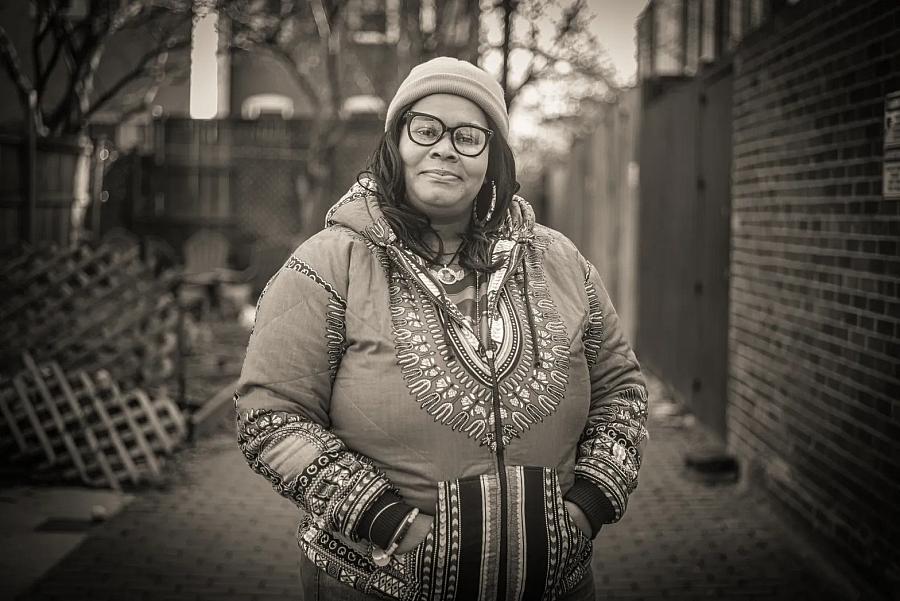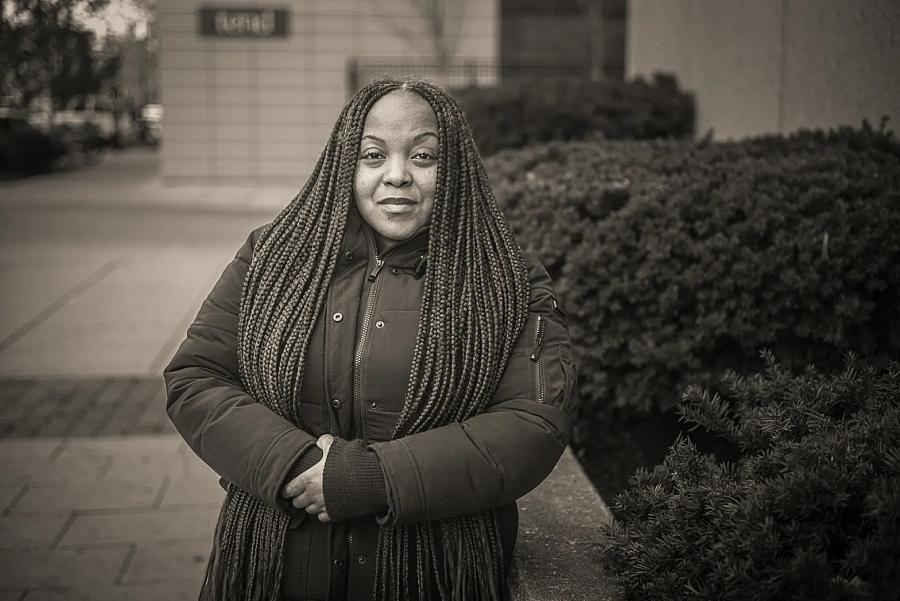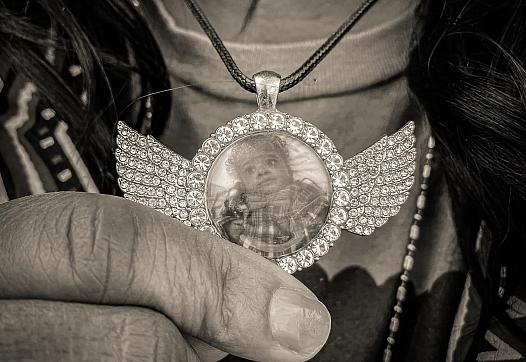We Were Here: Black Infant Loss in D.C.
The story was originally published by the Washington City Paper with support from our 2023 National Fellowship's Dennis A. Hunt Fund for Health Journalism.

Wakeya Thompson-Belt wears a charm with a photo of her son.
Credit: Darrow Montgomery
Wakeya Thompson-Belt and her husband, Kelvin Belt, were elated to find out they were having a baby. For the first six months, her pregnancy was uneventful, and she faithfully attended her prenatal visits leading up to their son’s June 13, 2020, due date. During the second week of April 2020, Thompson-Belt had two events on her calendar: her prenatal visit and her baby shower. She would only make it to one of those appointments.
“My first two trimesters were great. I had no complications at all,” Thompson-Belt says. “It wasn’t until that third trimester that things took a turn. I went to a routine prenatal visit and my [blood] pressure was elevated. I felt fine though. I didn’t feel like anything was wrong.”
The medical team checked her vitals and found the baby’s heartbeat. It was there, but faint.
“They just started calling all these doctors, and then I’m like, ‘What is happening?’” she recalls. “The only thing I could do was call my husband. I called my cousin and even my mom, and I was just like, bawling, like bursting out in tears.”
It was the start of the COVID-19 pandemic, when lockdowns and travel restrictions were in place. Her baby was in distress, and no one could explain why. Her plans for delivery were unraveling. The 42-year-old Ward 7 resident was terrified.
“I think the whole COVID thing is really what had me going, like, haywire, even though I didn’t feel it, my body was saying something different,” she says.
On April 8, 2020, Kelvin Belt Jr. was born via emergency C-section.
His hectic entry into the world would be the beginning of a 10-month struggle for life in the Neonatal Intensive Care Unit at Children’s National Hospital in D.C. Thompson-Belt and her husband did the best they could given the circumstances.
“We brought all this stuff up and his little stuffies and his clothes and we just made his little NICU room his personal room,” Thompson-Belt says. “We were talking about bringing him home. They made me feel like everything was OK from the very beginning, but it wasn’t.”

Wakeya Thompson-Belt
Credit: Darrow Montgomery
From the time her son started receiving care at Children’s, Thompson-Belt felt as if she was being left out of important decision-making. She questioned whether or not her son’s doctors were giving her complete information.
“I felt like they had a hidden agenda. I felt like there were secrets that were being held that I was not privy to,” she says. “He was on a breathing machine and then he was extubated so he was breathing fine. Then when I got in this meeting with the doctors one day, they were saying, ‘trach, trach,’ and I’m like, ‘What? He doesn’t even need a trach.’” (A tracheostomy is a procedure that allows a person to breathe through a surgical opening in the neck.)
As the staff worked on preserving little Kelvin’s life with a dietary supplement given intravenously (called total parenteral nutrition, or TPN), Thompson-Belt researched, interrogated, and consulted with the medical staff as much as she could. But nothing could stop the inevitable. Kelvin Jr. died on Feb. 19, 2021. His death certificate lists his cause of death as necrotizing enterocolitis, or NEC, a gastrointestinal condition that affects one in 1,000 premature infants. But the Belts believe that something more happened.
Thompson-Belt asserts, based on her research, that her son was given TPN for too long and that it caused the life-threatening gastrointestinal condition to return. She says she found out later that NEC is prominent in premature infants, but it’s mainly linked to formula and fortified milk, rather than breast milk.
“We had no idea this was gonna happen. We were told that he already beat NEC. His milk was fortified without our permission. He was supposed to have been given my breast milk only,” she says. “The gastroenterology team was supposed to have treated a case similar to our son’s and gave us high hopes only to fail us. We are still in disbelief.”
On a follow-up Zoom call with hospital staff months later, the Belts asked for clarity on what went wrong after being told that their son would be coming home. Belt asked if the staff knew that this was going to be his son’s fate. “My husband asked if they were just stringing us along. They said ‘yes,’” Thompson-Belt recalls with frustration.
A spokesperson declined to comment specifically on the Belts’ case due to patient privacy laws. In an emailed statement, the spokesperson says, “At Children’s National Hospital, we provide comprehensive care and support to all our patients and families. Our Level IV NICU follows rigorous protocols and guidelines to provide the highest level of care available for premature and ill newborns.”
Today, Thompson-Belt leans on her husband, her daughter, and her family for support. Some days are better than others. She holds tight to her faith. “God has sent me so many signs that my son is an angel,” she says. “I will keep fighting for him.”
Stories like Thompson-Belt’s are not unusual. Perinatal loss is a frequent occurrence in the District, and causes vary. In the past 10 years, there has been a groundswell of support to curb rising Black maternal mortality rates and save women’s lives. Infants are inextricably linked to those mothers, and they are at-risk as well. Black infants in D.C. are dying before they reach the 12-month benchmark. Even in a city with a plethora of resources like the District, it happens time and time again.
According to the 2022 DC Health Infant Mortality Report, the infant mortality rate from 2016 to 2020 was three to five times higher among non-Hispanic Black infants compared to Hispanic and non-Hispanic White infants, respectively. DC Health’s 2018 “Perinatal Health and Infant Mortality Report,” covering 2012 to 2016, found similar results. The report states that the leading cause of infant deaths are birth defects, or congenital anomalies. Although the causes of these defects are largely unknown, in some cases they can be linked to genetics or prenatal care.
Some common threads emerge in the risk factors and characteristics of infant deaths. The highest number of infants that are lost in the District are born to Black mothers and birthing persons who reside in wards 5, 7, or 8. They are either born premature (prior to 37 weeks gestation) or with a low birth weight (less than 5.5 pounds). March of Dimes, a national advocacy group dedicated to ending preventable maternal and infant deaths, issued a report in 2022, which stated that D.C. birthing persons with one or more chronic health conditions are 69 percent more likely to have a preterm birth.
Dr. Sharyn Parks Brown, epidemiologist in the Division of Reproductive Health at the Centers for Disease Control and Prevention, explains in an interview with City Paper that the final few days in the womb are critical for infant survival.
“That’s one of those areas that the maternal care world has focused a lot on; those late stages of pregnancy,” Parks Brown says. “There’s actually a lot of development that has to take place during the last two weeks of pregnancy. The baby can put on a lot more fat. There are changes in the brain neurology that occur in the last couple of weeks. There is also continued development of the lungs all the way through to the end of pregnancy.”
Underdeveloped lungs can lead to extended stays in the NICU, she notes. And adding weight helps infants better regulate their body temperature and blood sugar.
“So all of those things, when the baby is born just a couple of weeks early, can be more difficult, and they end up needing more care to get all of those systems stabilized,” says Parks Brown.
Access to care and resources play a major role in creating a healthy environment for infants. Between 2019 and 2020, there was a 2.8 percent uptick in obstetric providers in the District. According to the American Board of Pediatrics there are 350 pediatricians in D.C., and nearly 97 percent of residents have health care coverage, which is the second-lowest uninsured rate in the country. So where is the disconnect?
Mallory Mpare, director of maternal and infant health initiatives at the March of Dimes, says access to resources is one of the biggest impairments to local families. “I think that’s one of the key stories about D.C. is that we’re pretty resource rich,” Mpare says. “It’s not about the availability of resources. It’s really more about the challenges and barriers to accessing those resources.”
Challenges such as birthing hospital locations and transportation can greatly affect patient care. Two of D.C.’s obstetrics wards that served a large number of Black and low-income patients in the city have been closed for more than five years. United Medical Center, located in Ward 8, permanently closed their OB ward in 2017 after medical mistakes and low patient volume marred their reputation. A few months later, Providence Hospital in Ward 5 closed its obstetrics ward. Construction is underway for a new medical center in Ward 8, but it won’t be completed until 2025.
Women and birthing persons who live east of the Anacostia River travel more than six miles, or 25 minutes on average to get to a birthing hospital. In Ward 8, an area of D.C. with some of the highest rates of infant mortality, about 56 percent of the residents have access to a vehicle compared to 64 percent in D.C. overall. This means relying on expensive rideshares and Metro, which has been widely criticized for its unreliability and poor service.
“It takes some women twice as long as other women to reach maternity health care services, which can really mean a lot when you’re juggling between a job and childcare and the other responsibilities that you have in your life,” Mpare says.
Sherene and their wife, Elizabeth, were preparing for the birth of their son throughout most of 2021. Sherene, 27, carried the child and describes their pregnancy as “seamless” except for the occasional backache and other common pregnancy symptoms. The couple followed all the prescribed steps for having a healthy pregnancy including getting prenatal care from two medical professionals. (The couple asked to be identified by their middle names to protect their privacy.)
“I had prenatal visits with the midwife and then I had three ultrasounds with an [obstetrician],” Sherene says in an interview with City Paper. “And so during the ultrasound appointments, we did checkups. It was a little bit of overlap, but most of our prenatal care was with the midwife.”
Sherene planned a home birth, and the midwife was there when they went into labor, which lasted 12 hours. “Everything was fine until it wasn’t,” Sherene says.
She started to bleed unexpectedly at home, so the three of them rushed to MedStar Washington Hospital Center, where Sherene says medical staff disregarded their midwife’s input. Some hospital staff members didn’t acknowledge Elizabeth as Sherene’s wife and instead referred to her as “your friend.”
“They were asking if I like to use drugs. Asking me a lot of questions trying to say like, what happened was our midwife’s fault when we honestly weren’t even, like, considering anybody was at fault,” Sherene says. “You know, sometimes things go wrong in the birthing process, and we were just kind of just processing all of it. But they were very accusatory.”
Sherene had a ruptured uterus, which caused excessive bleeding and can be a symptom of drug use, research has shown. But Sherene says she denied medical staffer’s repeated questions, and they did not explain their rationale.
Sherene was prepped for surgery immediately after she arrived at the hospital. Their son was born via an emergency C-section on Nov. 16, 2022, at 41 weeks—one week beyond what’s considered a full-term pregnancy. But he was soon rushed to the neonatal intensive care unit at Children’s National Hospital, a separate facility about half a mile from Washington Hospital Center in D.C. NICU physicians called Sherene and Elizabeth while they were still at Washington Hospital Center to explain that too much time had passed without oxygen reaching his brain. The couple had just a few hours to get to the NICU and provide end-of-life care.
“The doctor explained that after running some tests, he didn’t have any brain activity,” Sherene says. “He kept having seizure activity pop up on the monitor, and that they couldn’t really figure out why or what was happening. He was in a lot of pain. She let us know that he wasn’t going to survive.”
Sherene and Elizabeth had previously discussed what they would do in the worst-case scenario. They didn’t want their baby to suffer or live with the help of machines. At Children’s Hospital, they bathed their son, took a few photos with family members, and created some quiet memories. Then they said goodbye, after just 31 hours of life.
The couple returned to Washington Hospital Center, where Sherene says the couple spoke with a social worker who helps parents cope with perinatal loss.
“She was the only person really that just treated us like normal people,” Sherene says. “Everyone else seemed like they were walking on eggshells or like they were scared to talk to us.”
Provider-patient interactions are a major part of the social determinants of health. Negative encounters can turn a stressful moment from bad to unbearable. The Georgetown University Center for Child and Human Development produced a report in 2020 titled Uncovering the Role of Racism in DC Reproductive Inequities. The report highlights how culturally incompetent care and institutional racism can erode the provider-patient relationship and negatively impact health outcomes for birthing persons and infants. Women and birthing persons who perceive discrimination while attempting to receive health care might be more likely to enter into prenatal care late, if at all.
A review of 15 studies on how racial and ethnic bias impacts patient care found that covert discrimination and institutional bias toward racial minority groups can manifest in several ways including longer wait times for assessment and treatment, rushing patients through appointments, misgendering, speaking in condescending tones, and not working collaboratively with the patient when considering treatment options.
Whitney Hewlett Noël, a birth doula and expert on racism and its impact on maternal care in D.C., says that the discrimination is palpable and can be based on several things.
“I think you can see it in D.C. where there’s like a stark socioeconomic divide, especially along racial lines,” says Hewlett Noël. “If providers are not accepting Medicaid, or if they are not friendly and not welcoming toward Medicaid patients, then that can present a problem. If you’re stigmatizing people who are enrolled in Medicaid, then those patients are not going to have great experiences. And they’re going to feel disrespected.”
The DC Health report on infant mortality shows that the infant mortality rate among Medicaid financed births was more than triple the rate of births financed by private insurance.
As part of her research, Hewlett Noël has spoken to parents who have described feeling discriminated against by medical staff based on where they live.
“Like, ‘Oh, they’re from this part of the city,’ and they’re making certain assumptions about them,” Hewlett Noël says. “And so yeah, discrimination can be based on geographic location as well.”

Amanda Davis
Credit: Darrow Montgomery
Amanda Davis was inconsolable on April 14, 2014. That’s the day her daughter, Jalia, died. She was 6 months old.
The last thing Davis wanted to hear was that she had to be strong or that God would never give her more than she could handle. She didn’t want to hear that, because she was still young, she would have the chance to have more kids. She didn’t want to hear about how much her 10-year-old son, Josh, needed her.
It all happened so quickly. Jalia was sleeping on a relative’s chest one evening at her home in Ward 8. They looked cozy, so Davis decided to leave them alone and head into the bedroom to rest. During the course of the evening, Jalia rolled over in her sleep to a position that she couldn’t get out of on her own. When Davis woke up, Jalia wasn’t breathing, and everything was spinning out of control.
“I called the ambulance,” she says. “The first responders were able to get a pulse, they intubated her, and airlifted her to Children’s [Hospital in D.C.].” After two days of surgery and respirators, Jalia died from a stroke caused by accidental asphyxiation.
Davis, a 28-year-old re-entry case worker for the District government, needed support coping with the loss, but it wasn’t there. Her friends didn’t know what to say. She continued to ask herself: “Why did this happen to me?”
“I didn’t really find any support for moms who lost infants,” Davis says. “I found that there’s a lot of support groups in the Black community for moms who lose teens to, like, gun violence. There’s a lot of resources and groups in Northern Virginia for moms who have lost infants. I would love to see that happen in D.C.” She wanted to connect with other Black mothers in the District who have experienced this specific type of loss.
Since then, Davis has had two more sons, who are now 8 and 2. She donated Jalia’s organs to the Washington Regional Transplant Community, and her kidneys, liver, and heart were given to transplant patients around the country.
Davis has found healing in prayer, intensive therapy sessions, and practicing Reiki—a Japanese technique that uses gentle hand movements to guide healing energy throughout the body. She’s leaned on friends who hold a space for her when she needs to talk. She recommends others who experience this kind of loss do the same. “If it’s not therapy or church, then get to a space where you’re willing to talk because keeping it in definitely is not healthy,” she says.
Accidental deaths, the second leading cause of infant deaths in D.C., accounted for about 15 percent of infant deaths according to the DC Health Infant Mortality Report.
Separately from accidental deaths, sudden unexpected infant death syndrome, or SUIDS, is also a concern for new parents and providers. According to the CDC data from 2016 to 2020, 54 infants have died due to SUIDS in D.C., which represents about 116 per 100,000 live births. Although SUIDS and accidental deaths are, by definition, difficult to predict, they are not entirely impossible to prevent.
Education is the start. In 2022, researchers worked with focus groups in the District to find potential causes of infant mortality in relation to infant sleep practices among D.C. caregivers. The results showed that caregivers’ knowledge about safe sleep practices varied. Caregivers often made their decisions about sleep positions based on what position would promote the best sleep for the infant. They also shared that sharing a bed was more convenient for breastfeeding and to create a better bonding experience. Some parents shared that they kept their baby in bed with them to protect them from vermin or gunfire.
Parks Brown, the CDC epidemiologist, says there are nationwide efforts to educate parents and caregivers about safe sleep practices that can potentially drive down mortality rates.
“So we know that the major contributors to infant mortality are preterm birth and sudden unexpected infant deaths,” Parks Brown says. “There are collaboratives across the country that work to do quality improvement work in hospitals, for moms and babies, and they are also working to educate and promote safe sleep.”
On a local level, advocacy organizations such as Safe Sleep DC work with neighborhood-based collaboratives to educate parents and caregivers on the importance of sleep positions. They provide workshops and in-home consulting on best sleeping practices, and demonstrations for safe sleep positions.
In D.C., the alarming disparity in Black infant mortality rates underscores a critical health care challenge. The root of this issue lies in limited access to both prenatal and postnatal care, exacerbated by the geographical distance between mothers’ residences and essential health care resources and hospitals. The current crisis is intensified by a lack of comprehensive solutions aimed at preventing the tragic loss of Black infants and addressing the broader systemic issues contributing to disproportionately high mortality rates within this marginalized, underserved population.
In part two, we will take a closer look at stillbirths in D.C.


